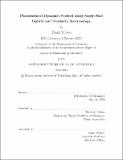Photoinduced Dynamics Studied using Single-Shot Optical and Terahertz Spectroscopy
Author(s)
Gao, Frank Yi
DownloadThesis PDF (27.59Mb)
Advisor
Nelson, Keith A.
Terms of use
Metadata
Show full item recordAbstract
This thesis focuses on the advancements made in and the applications of echelon-based ultrafast single-shot optical and terahertz (THz) spectroscopy to study irreversible photoinduced dynamics and materials far from equilibrium.
First, we motivate the understanding of photoinduced material responses as initiated by, and probed with, ultrafast laser pulses, including the techniques of conventional optical pump-probe spectroscopy and optical pump THz probe spectroscopy.
Next, we provide an overview of various single-shot techniques, including a detailed discussion about the design and characteristics of echelons for use in single-shot optical and THz readout. In addition, we discuss the development of a novel two-arm noncollinear parametric amplifier with exceptional parametric conversion efficiency.
We then move on to applications of single-shot spectroscopy studying the semimetals bismuth and tellurium. In bismuth, we observe anomalous optical phonon behavior under conditions of double pump excitation, including the apparent beating of multiple A1g-like phonon modes. In tellurium, we demonstrate that laser-induced amorphization with ultrafast pulses is purely thermal and results from the rapid melting and cooling of the tellurium lattice at high fluences.
After this, we discuss work probing the photolysis of I3– in glass-forming liquids across an extensive range of solvent viscosities and temperatures. We demonstrate that the increased rigidity of the solvent network at low temperatures and high viscosities results in an increasing fraction of photofragments being unable to break out of their solvent cage, which results in the increased formation of caged-contact pairs. We identify a clear spectral signature of this caged species and assign a binding energy to this species.
Lastly, we observe the real-time formation of a persistent hidden quantum (H) phase in the charge density wave material 1T-TaS2. We demonstrate that the formation of this H phase is ultrafast, electronic in origin, and corresponds to a near-complete melting of the charge order. Furthermore, we identify a persistent increase in the optical and THz conductivities as the primary order parameter for this transition.
Date issued
2021-06Department
Massachusetts Institute of Technology. Department of ChemistryPublisher
Massachusetts Institute of Technology